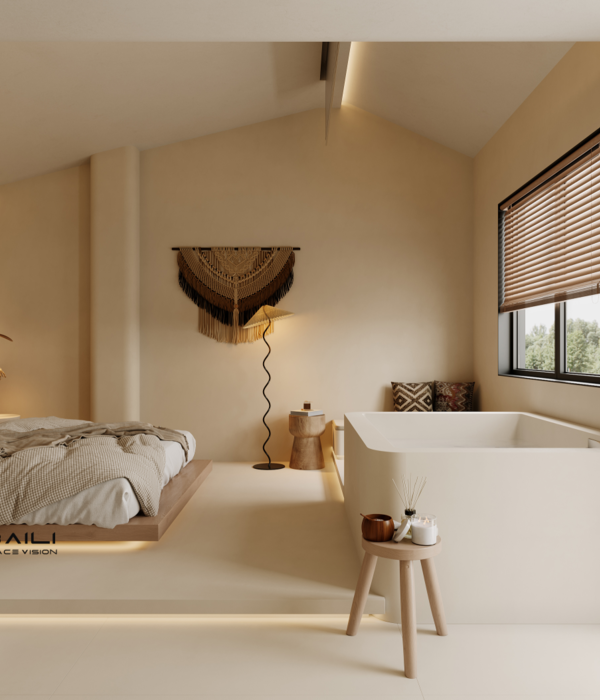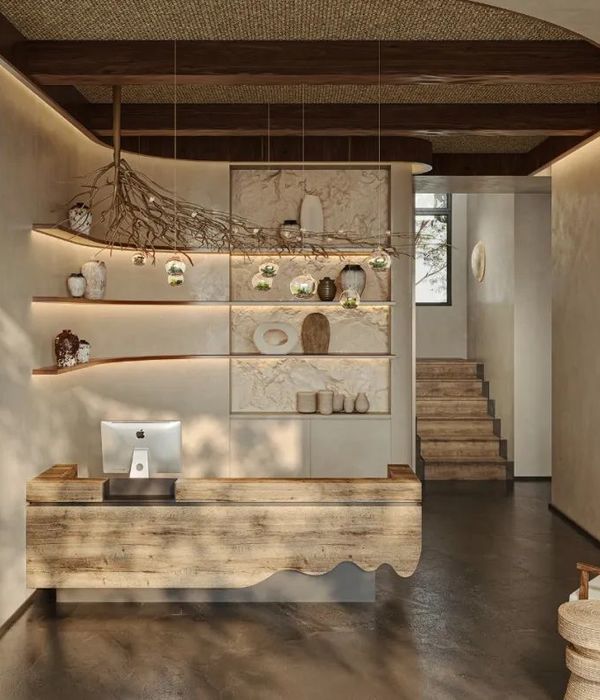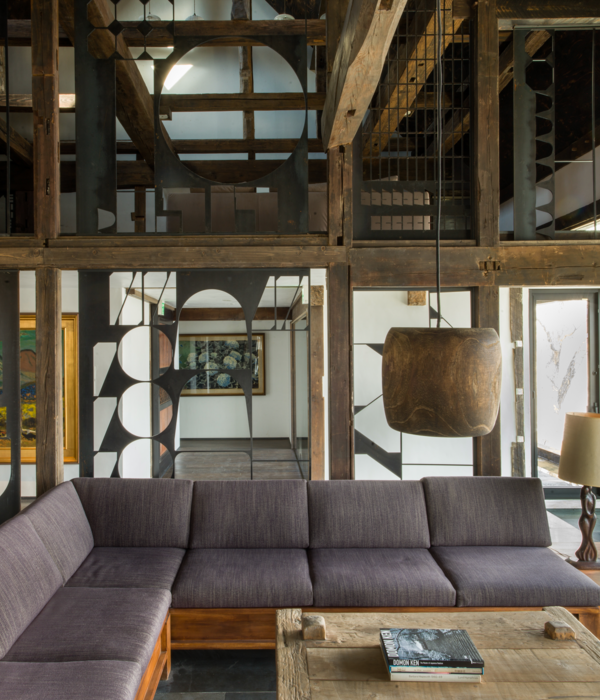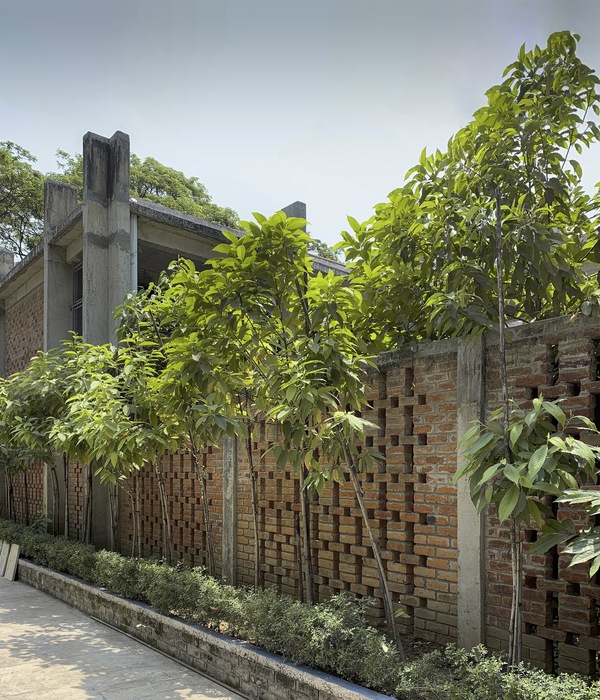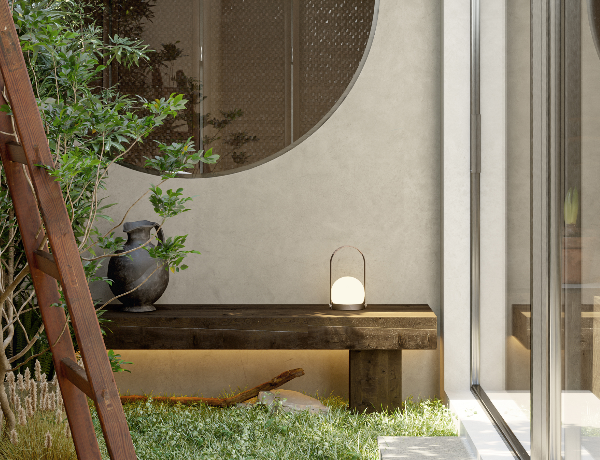穿过喧嚣的偏岩古镇,是零落的三两个村庄,以及层层的田。顺着黑水滩河一路朔源,行进于山林水库的小径。小径上游可以到金刀峡水库,下游则抵达偏岩古镇乃至重庆。再绕过一道弯,首先映入眼帘的是一座时间久远的石拱桥。桥拱之下的一侧岩石,被凿开几个洞窟,摆放佛像,成了村口的一座小庙。洞天福地。从桥上环绕下来,穿过拱洞小庙,发现这座废弃的建筑,伴着几株黄葛古树映入眼帘。
石桥、水湾、庙窟、古树、废弃建筑,构成我初次看到场地的整体意向。
▼现状,Present situation©王浩
Crossing the bustle of the ancient town Pian Yan, there are several scattered villages and layers of farmlands. Marching the paths in forest alone the Heishuitan river. This path upstream to Jindaoxia reservoir and downstream to Pianyan town even to the main districts of Chongqing city. Turning one more corner, the first thing comes to eyes is an ancient stone arch bridge. One side of the rock under the bridge has been chiseled into several caves and placed with Buddhist statues, which became a small temple at the entrance to the village. Wander down the bridge and through the temple, you can see this abandoned building accompanied by several ancient Ficus virens.
The stone bridge, the water bay, the temple, the ancient trees and the abandoned building have formed my general perception of the site when I first saw it.
▼桥拱之下的五通庙和改建之后的建筑 The Wudao Temple and the finished building beneath the arch bridge © 金伟琦
废弃的建筑原来是座小学校,走进一间间教室,黑板面,宣传栏,粉笔盒、镶嵌的瓷砖地图,往昔的历史在建筑中留下了斑驳的痕迹,又像手纹一样藏了起来。
The abandoned building was originally a primary school. When you walk into classrooms, you can see the blackboard, the Bulletin board, the chalk box, and the inlaid tile map. The past has left a motley trace in the building, and it is hidden like hand prints.
▼改建后入口处巨蟒般的树枝,The giant branch at the entrance© 金伟琦
西侧次入口,穿过屋顶的黄葛古树,Side entrance and an ancient tree goes through the roof© 金伟琦
于是,需要明确,元门民宿小学更新改造,其中需要恢复的不是那无可考据的物质形式及轻易获得的具象物件,亦不是一个植入住宿功能的旧有学校的怀旧布景。
Therefore, it is necessary to make it clear that what needs to be restored in the Yuanmen Primary School are neither the unverifiable physical form and easily acquired figurative objects nor a nostalgic setting of an old school implanted with an accommodation function.
▼树木从新建坡顶中穿过,像是要把建筑举起来,The ancient tree is like lifting the sloped-roof© 谢凯
场地现状的三座建筑中,前排的南楼为两层建筑,上下各 4 间教室;后排的北楼为三层建筑,除了一翼为教室之外,其余小开间为教师办公及住宿。南楼和北楼为砖混结构,由于地势原因,南北错了一层高差。西楼的年代更为久远,石块垒砌的墙体,木梁搭建的楼板。
也许,通过山地建筑的特质,内部的多重动线梳理,可以试图唤醒当初孩子们在这一高高低低的场所中游玩,嬉戏的场景;以及通过攀登,环绕,遮挡,凝视从而获得周围不同景观的视野。这两者均是从普通对象的呈现来激发情感,便更有价值。
Among the three buildings in the site, on the south is a two-storey building with four classrooms on each story. On the north is a three-storey building with one ring for classrooms and other small rooms for teachers’ offices and accommodations. The south building and north building are brick concrete structure, and because of the terrain, there is a level difference between two buildings. The west building has a much longer history, with stone walls and wooden beams.
Perhaps, through the characteristic of mountain architecture and the internal multiple circulation neatening, we can try to awaken the scene of children playing up and down. And by climbing, circling, shading and gazing, different views of surrounding landscapes are acquired. Both are inspired by the presence of ordinary objects and which make it more valuable.
▼西楼和北楼之间一株黄葛树,The Ficus virens between the buildings© 金伟琦
▼廊道尽端的树干,The trunk in the end of the corridor© 金伟琦
改造从重新梳理动线开始,南楼由于地势较低,加之古树环绕,如果从南楼进入,通过楼梯爬升,会有一种逐渐明亮的上升的氛围变换。为强化这种氛围的转变,西楼的二层在拆除后,决定不进行客房扩建,而是打通视野,仅搭建一单坡屋面。
结合开辟出来的庭院,流线到了西侧的尽端,经过最后一个单坡屋檐的压低,穿过一道矮墙之后,视窗被急剧放大,近处的溪流,远处的山体,散散落落的村房。纳入眼底。动线的转折,低处的阴影隐匿,到了高处的阔朗通达,使这里成为身体感知的放大器。
▼场地内多重动线,Multipal functional flow©刘立超
The reconstruction started from the replanning of circulation. Because of the south building is lying on a lower terrain and surrounded by the ancient trees, there is a feeling of gradually bright and raising atmosphere change if you enter from the south building and climb the stairs. In order to strengthen this feeling of atmosphere change, we decide to built a single-slope roof rather than carry out the expansion of guestrooms after the demolition of the west building’s first floor, so that we obtain a widen transparent view when we stand on top of the stairs.
Combined with the new courtyard opened up, the visitor reaches the end of west side. The visual view is suddenly enlarged after passing through the lower eave of the single-slope roof and a low wall beneath it. The stream nearby, the mountains in the distance, and scattered village houses are all captured by your eyes. The winding walking flows, the hidden shadow in the low place and the transparent in the high place make this place become the amplifier of body perception.
▼南楼通向北楼的台阶被保留下来,由暗到明的转变,The preserved stairs between the north and south building, the change from dark to bright© 金伟琦
通过被压低至 2.2 米的单坡屋檐后,景色被放大,The visual view is enlarged after passing through the lower as 2.2 meter single-slope roof© 金伟琦
▼单坡下的漏墙,A leaky wall under a single-slope roof© 金伟琦
事实上,这条动线改变了很多。主入口的偏移,西边打开的视野,两条次流线出入口被小心的隐藏起来。三座房屋,以及四棵黄葛树的关系得以重置。
在元门小学民宿里,结合地形,动线的编排与庭院的挖掘,为它的多次阅读打开了可能性。高低不同的身体姿态,每一次转身,希望能提示出物体和身体的关系。视线和存在,来访者以一种不熟悉的方式看到熟悉的东西,也许是一种难得的体验。
In fact, this walking flow has changed a lot. The offset of the main entrance, the new view opened up on the west, and two entrances of secondary walking flows are carefully hidden. The relationship between three houses and four Ficus Virens has been reset.
In this project, the combination of the topography, the arrangement of the walking flows and the excavation of the courtyard opens the possibilities for multiple experiencing. The relationship between the body and objects is what we emphasize in our design, we hope visitors various body posture, each single turn around can help them see something familiar in an unfamiliar way, maybe it is a rare experience.
▼在高处,风景变得通透与敞亮,亦可以俯瞰低处的庭院与瓦房,Overlooking the lower courtyard and tiled house from the third floor© 金伟琦
▼阳台,balcony
作为动线上节奏转化的重要节点之一,由客房围绕的庭院还得保证一定的隐私性:将两排楼之间的空地为核心,三栋建筑围合起来,塑造一个带有高差,环绕的庭院,通廊将不再孤立,而是庭院的一部分。新的改造在东侧结合高差打通了一个向上的台阶通道。如此,廊道不再是尽端而是可以被环绕。
庭院铺上薄薄水面,水面的反射将景色纳入庭院。与此同时,在有高差的界面处,间距 6 公分的菱形松木格栅划分了庭院,同时也模糊了前楼廊道和后楼庭院间的距离,确保了一定的隐私性。扩建的屋面适当的延伸了接近一米的距离,强化了庭院的围合感。垂下的格栅距离台地 0.6 米,对于下侧的廊道中的人来说,视线得以水平展开。
▼高低台地的内庭院,The courtyard with height difference©刘立超
As one of the important nodes of the transformation of rhythm of the walking flow, the courtyard has to ensure the privacy of guestrooms surrounded. The open space between the two rows of building is taken as the core, and three buildings are enclosed to create an encircled courtyard with height difference. The corridor will no longer be isolated but a part of the courtyard. A new-built upwards stairway on the east end of the corridor was created so that the corridor is no longer the end but part of the encircle.
When the courtyard fills up water, the reflection of the water brings the scenery into courtyard. Meanwhile, at the interface with height difference, the rhombic pine grills with a spacing of 6cm divides the courtyard, blurs the distance between the corridor and the courtyard, and ensures a certain extent of privacy. The expanded roof extends appropriately 1 metre to strengthen the sense of enclosure of the courtyard. The vertical grilles are 0.6 metre away from the platform, for the people in the corridor below, their sight expands horizontally.
▼廊道和中庭之间的高差被处理成青石台面,水面被举起 The height difference between the corridor and the atrium is treated as a bluestone platform, as the water surface is lifted© 金伟琦
▼庭院内景,The courtyard© 金伟琦
此外庭院还承担了雨水收集的作用。雨水从坡顶流入金属檐沟,通过竖直铁链被引导进一个层层跌落的混凝土引水台,在卸下冲击力之后,缓缓流入庭院中的水池。
Besides, the courtyard also plays the role as a rainwater collector. Rainwater flows from the top of the slope into the metal eaves gutter, and is guided into a falling concrete pilot bridge by vertical iron chains. Finally, it slowly flows into the pool in courtyard peacefully.
▼内侧坡顶结合景观水台的雨水疏导,The inner slope roof is combined with the landscape water platform for rainwater diversion© 金伟琦
俯瞰旧瓦屋面,水庭与格栅屏风,宽大石台下是排水管廊,The old tiled-roof, grille and drainage pipe hidden beneath the stone platform© 金伟琦
▼雨水排泄系统(金属檐沟,雨水管,明沟,暗沟),The rainwater drainage system (Metal eave ditch, rain pipe, open ditch, underground ditch)©刘立超
有组织雨水的仪式化,The organized rainwater© 金伟琦
▼屋檐,the roof
元门民宿 13 间客房由原有的校舍演进过来。南楼的标准教室尺度设计为带有夹层的客房,窗口面向溪流与古树;北楼西翼的音乐教室设计为三面景观客房,其余办公室和员工宿舍根据面宽进深被设计为一到两开间的标准间。所有客房的阳台或窗口,塑造出不同的景观视野。
The 13 guestrooms of Yuanmen B&B are evolved from original school building. The standard classrooms in the south building are designed as guestroom with a mezzanine, windows face to the stream and ancient trees. The music classroom in the west ring of the north building is designed as guestroom with landscapes come from 3 direction, and the rest of offices and staff dormitories are designed as one to two bay standard rooms according to its deep and width. All the windows and balconies of guestrooms create different landscape views.
▼透过西翼客房外看新建的石板瓦屋顶,Observe the new-built slate roof from the west wing guestroom© 金伟琦
▼南楼大教室客房型,The classroom guestroom in the south building© 金伟琦
▼南楼大教室客房型-- 入口处桌台与后面的阳台,The table in entrance and the balcony in rear© 金伟琦
▼楼梯,The interior stairs© 金伟琦
▼北楼大教室客房型,The classroom guestroom in the north building© 金伟琦
对于公共餐厅及民宿接待,南楼一层将四间教室的横墙适当打通,并进行结构加固,最大化的加强了这里的公共开放性,其中结合运营,公区餐厅亦设有自助式厨房,原有内侧支撑山体的岩廊结构暴露出来,作为自助厨房的背向,而将窗外的水平风景,作为身体的面向。
For the public restaurant and reception, the horizontal walls of four classrooms on the ground floor of south building were opened properly and reinforced in structure, to maximize the strengthening of openness here. The public restaurant is also equipped with a self-service kitchen, and the rock structure which supports the mountain is exposed intentionally as back of self-service kitchen. The scenery outside the window is what guests are facing with when doing cooking.
▼将背后的山体岩廊作为自助厨房的操作台面的背景,The exposed rock structure as the background of self-service kitchen© 金伟琦
▼公共餐厅,Public restaurant© 金伟琦
建造一扇窗户,最基本的建筑问题是采光、通风、观景。我们希望采取一种系统,获得建筑学意义上类型的统一:将以上功用分开来,通风作用的部分可以置于下侧或偏侧,按照实际需求满足通风量即可;同样的道理,采光玻璃的横框可以置于高处,如此则可以确保人视点的尺度时,观景的玻璃的无框最大化;
The most fundamental architectural problems need to be solve when designing a window are daylighting, ventilation and viewing. We wish to acquire a typological unity in architecture by adopting a new system— Separate these functions in different parts. The ventilation part can be placed on the lower side and meet the actual ventilation demand. In a same way, the horizontal daylighting glass frame can be placed on top of the window so as to ensure the maximization of the frameless viewing in a scale of mans point of view.
相同系统的不同门窗的类型,Different types of doors and windows in a same system©刘立超
结合家具,改造前后的窗系统,The window system before and after the renovation©刘立超
具体来说,二楼客房需要敞亮,新植入的木窗,上部直接利用旧有过梁固定,而下部,木质的窗下家具结合通风移动扇。中间用大的固定玻璃将光线较好的引入室内。一楼则刚好相反,餐厅需要阴翳柔暗的氛围,这样坐在窗边的餐者可以更为仔细地识别窗外景色。一种类似两分窗的措施将外部的景色分割,上部承担采光作用,中部为获得视野用披水屋檐压低视线,下部则为通风采光。
随着我们阅读角度的改变,通过台阶,屋檐,窗洞,瓦片,我们得以重新去观察这几棵树与河水,拱桥的具体形态,这将揭示它伴随树木与溪流继续存在的可能。
To be specific, the guestrooms on the first-floor need to be brighten up. The upper part of the newly installed wooden window frame is fixed by the old lintel while the lower part is made of wooden furniture combined with the mobile ventilated fans. In the middle part, a big fixed glass leads the daylight into interior space. In contrast, on the ground floor the restaurant needs a dark and soft atmosphere so that the guests sitting by the window can recognize the view more carefully. A measure like two-part window divides the outside view, the upper part takes the role of lighting, the middle part uses the water eaves to lower the sight line and the lower part is for ventilation.
With the change of the perspective of looking things, through steps, eaves, windows and holes, we are able to re-observe the specific form of these ancient trees, streams and arch bridge, which will reveal the possibility of this buildings continued existence along with trees and streams.
▼接待厅窗前通风横窗与水平雨檐使得风景归属于个体,The ventilated windows and horizontal eaves in front of the reception windows make the scenery belongs to the individual© 金伟琦
在餐桌前的拱桥与古树,风从下方穿过,The arch bridge and the ancient tree outside the restaurant© 金伟琦
接待厅侧窗外的折型坡屋顶,A folding sloped-roof outside the window of reception©李萌
▼客房外折叠座椅栏杆(平时收起来可以当做栏杆防止小孩坠落;抽烟时可以当做美人靠)The rail of the folding seat in the guest room© 谢凯
▼北楼二层客房内透过门窗看前面的旧瓦屋顶,View from the first floor guestroom in north building© 金伟琦
▼桥上看民宿入口,View the entrance from the bridge© 金伟琦
▼桥下看民宿入口,View the entrance beneath the bridge© 金伟琦
▼对岸眺望,View from the other side© 金伟琦
▼轴测拆解示意图,Axonometric exploded diagram ©刘立超
▼总平面图,site plan©KAI 建筑工作室
一层平面图,plan level 1©KAI 建筑工作室
▼二层平面图,plan level 2©KAI 建筑工作室
▼三层平面图,plan level 3©KAI 建筑工作室
▼四层平面图,plan level 4©KAI 建筑工作室
▼屋顶平面图,roof plan©KAI 建筑工作室
▼立面图,elevations©KAI 建筑工作室
▼节点,structural details©KAI 建筑工作室
{{item.text_origin}}





